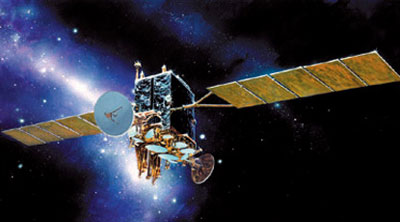TSAT: unobtainium urgently neededby Taylor Dinerman
|
| No one doubts that all future war in going to be information-heavy, but how and where that information is going to be used needs to be better examined. |
The Transformational Communications Architecture (TCA), of which the TSAT will be the crown jewel, is supposed to begin operations when the first of six of these satellites is launched in 2013. They will combine very advanced radio frequency (RF) and laser communications to provide a system-wide capability of dozens of gigabits per second to both fixed and mobile users worldwide. It will provide thousands of channels for RF users and dozens for systems that need a laser element. It is hoped that there will be so much bandwidth available that even the hungriest data hogs, such as a future highly-capable version of the Global Hawk UAV, will be satisfied.
The TCA is supposed to be one of the principal enabling technologies of the Pentagon’s future network-centric concept of operations. The fighting in Afghanistan and Iraq is beginning to put this whole “net-centric” idea into question. No one doubts that all future war in going to be information-heavy, but how and where that information is going to be used needs to be better examined. For example, perhaps a unit leader needs for his or her intelligence provider to conduct a data-mining operation in order to locate a particular type of enemy activity, say bomb building. Does it make sense to use “reachback” systems and have people based in Virginia or Florida do the work, or would it be better done by troops in theater, who are intimately involved?
More important the troops in the field are beginning to ask if the lightweight forces of the future can really stand up to likely enemy firepower. It is not enough to say that thanks to net-centric systems vehicles will be able to avoid or destroy enemy weapons before they can effectively attack US forces. Communications can give the US a major battlefield advantage, but they cannot change the fearsome and confusing nature of war itself.
TSAT is supposed to combine laser communications with RF systems on and unprecedented scale and with a level of complexity that is equally unheard of. To many in the Congress this sound like the kind of overpromising that they have heard before, especially about the SBIRS program, so they moved to cut the development budget for TSAT.
| If the space systems procurement people want to rebuild some confidence in the project, they might want to consider rethinking what they mean when they say “risk reduction”. |
In fact TSAT is in what the DoD described as the “Risk Reduction and Design Phase”. The inherent contradictions inherent in this phrase may be one of the reasons why they are having such a hard time on Capitol Hill. If they are already working on a design it mean that they have chosen essential elements of the system and the “risk reduction” part of the project only applies to technologies that have already been identified. This means that instead of working in a number of areas to find what may be the best potential answers to the requirement they have chosen solutions that are barely workable now and need risk reduction money to make them work.
If the space systems procurement people want to rebuild some confidence in the project, they might want to consider rethinking what they mean when they say “risk reduction”. If they are actually dealing with elements that have a high technology readiness level (TRL) then they should not have too much trouble making their case to the relevant Congressional committees. If not, then they should not try and improve the TRLs by simply throwing money at the problem. They should instead be looking at ways to effectively test system elements before they find themselves committed to a program that might end up costing $20 billion or more.
There is a good case for flying a couple of precursor missions, particularly to test the laser communications subsystems in the space environment. This kind of testing would allow the developers to debug the equipment without having to tell both Congress and the warfighters that the operational system they were promised is going to be a few years late and a few billion over budget. There are lots of small satellite options out there that might be suitable to carry the test elements. If the Air Force can show that they have made parts of the system work in space, then they may find that Congress will be willing to support the project. However, if they keep trying to sell risk reduction without hard proof that they can make the technology work the way they say it will work, then they will continue to face Congressional skepticism.
